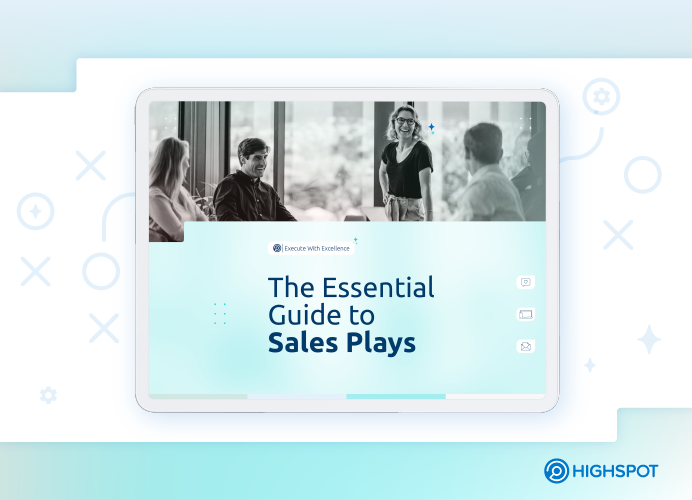Looking to understand what a sales playbook is and how it can help your sales team? We’ll run you through the basics in this article.
We’ll look at:
- What a sales playbook is
- Benefits of a sales playbook
- Sections to include
- Tips for creating your playbook
What is a sales playbook?
A sales playbook is a go-to guide for your salespeople to refer to at a glance. It should hold all the key information that a sales rep would need to know while selling.
Your playbook should contain all the sales plays, prospect information, tactics, and sales methodology your sales team will need to close a deal - without wasting time looking for resources.
Benefits of a sales playbook
There are loads of great benefits to using a sales playbook to support your team. Here we’ll discuss what just some of these are, and how they can help your reps.
Cement onboarding
Having all this information in one place can help to cement the onboarding process. It’s a well-known fact that learners will forget information, especially when it’s thrown at them over a short period (like during onboarding!).
We’re not saying a playbook replaces onboarding - it doesn’t - but having all the information together can help new reps get up to speed and stay up to speed by having that playbook to refer back to.
Empower sales reps
Giving your reps all the information they need to sell empowers them to make decisions on the fly and with confidence, while still having some guidance and being reassured by the playbook for when the going gets tough.
They can easily check back to the best practices and sales plays when they need a helping hand.

Cuts response time
Looking for resources to send to prospects can be really time-consuming - leading to longer response times. A sales playbook keeps all your critical information in one place so that your reps can quickly find what they’re looking for.
In turn, this helps to cut down their response times and get back to eager prospects sooner.
Shares best practices
Your top salespeople will have some good strategies for selling, and sharing these insights with the team can help to improve everyone’s knowledge and help them sell better. Keeping these best practices in the sales playbook means your team knows where to look for them if they need a refresher.
Avoid common pitfalls
Odds are, your sales reps are probably making similar mistakes to each other. By outlining these in the playbook and suggesting solutions, or more providing information on the topic, these mistakes can be avoided in the future.
Some common mistakes are selling to the wrong prospects, misselling, and giving prospects a disorganized experience.
What to include in a sales playbook
A sales playbook varies from company to company since each has their unique target prospects and products, but here are some key things to consider including in your playbook.

Normally our templates are exclusively for SEC members - but you can have this sales playbook template on the house!
Company overview
A quick overview of your company can help to set the tone for your reps.
Some things to consider including:
- Brief value proposition
- Key goals
- Broad target audience
- Industry
- Product offerings
- Points of contact for different issues/questions/departments
Sales team structure
This section should show your reps how their team is structured and what their role and responsibilities are. It’s really helpful in ensuring that each rep knows who they can go to for help with a specific sales question.
Having an outline of who works where and where to go can help to build your team and orientate new reps.
Messaging and positioning
Keeping consistent product messaging and positioning is key. That’s why your sales playbook should include key messaging details to keep sales reps on the same page.
Some things to include in this section are:
- A detailed value proposition
- Elevator pitch
- Product positioning
Product overview
Having a detailed view of each of your products can help your salespeople quickly answer nitty gritty questions from your prospects - so it’s a must in your playbook.
Include the key features and benefits of each product offering along with technical details, integrations, services, and pricing. You may also want to include the product roadmap showing upcoming developments.
If your organization has many products that work in tandem, it may be helpful to include some information about how they work together. This can help to inform your reps about upselling or cross-selling opportunities.

Competitive analysis
Including some information about competitors and the industry landscape can help your sales reps to understand their prospects’ other options. Giving a breakdown of the differentiators of your products compared to competitors can give further insights to your sellers.
You can’t just ignore the fact that your competitors exist. Your prospects are likely aware of them and exploring them as an option as well, so this section can prepare your sales reps for the inevitable questions about your rivals. That way, they don’t get caught off guard.
Buyer personas
A key part of an effective sales playbook is outlining the buyer personas. This can help to avoid selling to the wrong prospects.
Some information to include about each persona is:
- Job title and seniority
- Company type and size
- Pain points (company and personal)
- Purchase authority
- Specific features/benefits/concerns
- Any specific resources relevant to the buyer persona
Sales methodology
To help your sales reps provide a consistent experience to prospects, ensure to outline the sales methodology you want them to follow.
Make sure to include a description of what the methodology is and how it is applied at your company to keep your team on the same page.
Sales plays
Sales plays are a series of steps your sales team should take in various scenarios. In your playbook, it should be clear when (and by whom) each play should be used, and what the strategy behind the play is.
You should customize your plays to your organization’s prospects, sales strategy, and target buyer’s journey. Somewhere between 10 and 50 plays should give your sales reps the information they need for a variety of challenging situations.
Remember to include recommended steps, time frames, and relevant resources for each sales play.

Check out our essential guide to sales plays eBook in collaboration with Highspot!
Case studies and other resources
Having all your case studies in one place can help your sales team to select the right one as validation for their prospects.
You should also include the product, persona, use case, and industry the case study is from, alongside the key points in the case study. You should also include any other key content that your salespeople will need to sell effectively.
KPIs and sales goal
You can also opt to outline key KPIs and goals that your salespeople should be working towards, to keep their targets top of mind and help them to achieve their sales goals. New hires will also understand what is expected of them in their new role.
Tips for implementing a sales playbook
We know you’re excited to start writing your organization’s sales playbook - but we have a few tips for you before you get started.
- Involve your team: Writing a playbook isn’t a one-person job, make sure to involve your team and get their insights on what they’d like in the playbook.
- Ensure adoption and training: Having a playbook is great but if no one uses it (or knows how to use it) then it’s practically useless.
- Use tech & resources: There are tools and resources all around to help you build an intuitive sales playbook for your reps.
- Evaluate your processes: Do your current processes make sense and work? If not, it might be better to change them before writing the playbook.
- Keep it updated: Regularly updating your playbook keeps it relevant and helpful for your team.
- Use a template: Structuring an entire playbook can be time-consuming so make use of a sales playbook template to help yourself out.
Final thoughts
A sales playbook can help your team to get better results by providing them with all the information they need in one place. This helps new reps settle, empowers new and current sales reps, and helps to avoid mistakes.
When creating a playbook it’s important to include product information, buyer personas, and additional resources. Involving your team is the best way to create an effective sales playbook that works for your team.

Join 4,500+ of your sales enablement peers in our Slack community, and start networking, idea-sharing, and more - today!


Sales enablement insider
Thank you for subscribing
Level up your sales enablement career & network with sales enablement experts
An email has been successfully sent to confirm your subscription.
 Follow us on LinkedIn
Follow us on LinkedIn





